
- Index
- Band Type
- Brand
- Case Finish
- Case Material
- 14k Gold (15)
- Brass (66)
- Bronze (14)
- Chrome (44)
- Enamel (32)
- Gold (32)
- Gold Filled (189)
- Gold Filled G.f. (13)
- Gold Plated (139)
- Metal (20)
- Nickel (14)
- Rose Gold (15)
- Silver (305)
- Silver Plated (15)
- Solid Gold (21)
- Solid Silver (33)
- Stainless Steel (99)
- Steel (14)
- Sterling Silver (287)
- Yellow Gold (149)
- ... (3163)
- Caseback
- Closure
Louis Audemars Grand Complication 213g / 7Oz 18k Gold Pocket watch Book & Box
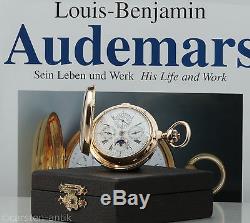
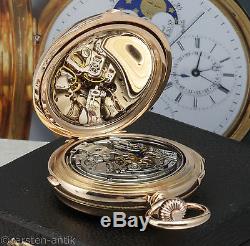
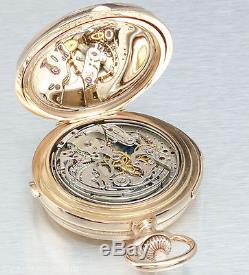
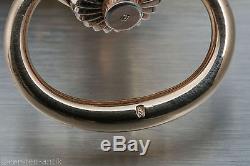
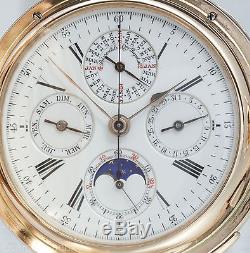
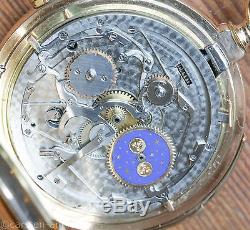
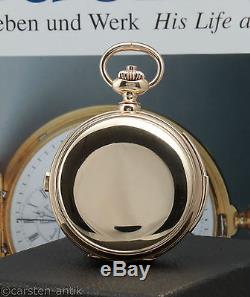
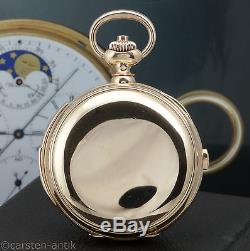
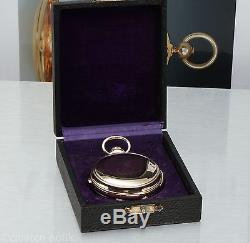
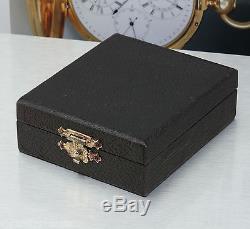
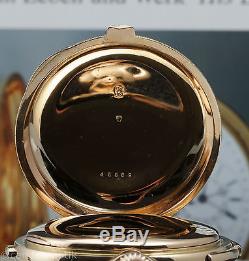
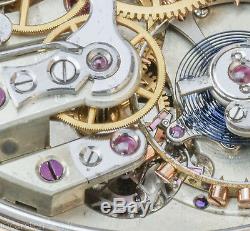


LOUIS AUDEMARS, MADE FOR POITEVIN, AN EXTREMELY HEAVY FINE AND RARE 213g 18K GOLD HUNTER MINUTE REPEATING PERPETUAL CALENDAR POCKET WATCH WITH MOON PHASE, LUNAR CALENDER & CHRONOGRAPH - with Leather box & The AUDEMARS BOOK IN MINT CONDITION. Case: Extraordinary heavy, "bassine et filets" 18k gold case, polished, The case is stamped with Swiss gold hallmarks, 18k, and case number 45 559. The ring has a French gold import mark.
Chronograph buttons at 12 Slider for the repeater at 6 The case is in mint condition. A similar Watch is depicted in the Audemars book on page 468. Enamel dial: , radial Roman numbers outer Arabic five minute division, gold spade hands, four subsidiary dials for month and leap year, day, date, moon phases, lunar calendar and Chronograph with blued steel hand, moon phase with cobalt blue enameled golden moon phase disc and golden moon and stars. The Original Hands and dial are in mint condition.
Audemars erbauche Bridge movement, rhodium -plated, fausses côtes decoration, very finely ground and bevelled chronograph steel parts, Gold chronograph wheels, ratchet wheel, 2 hammers / 2 gongs, wolf teeth winding wheels, gold screw compensation balance, index spring fine adjusting device, Audemars counterpoised lever. The movement is Stamped under the dial with the Louis Audemars movement No. 38 434, and B Pvin for Bernard Poitevin, Genève and Paris. A similar movement is depicted in the Audemars book on page 479. To the best of our knowledge, Audemars produced a small amount of this type of watch. The watch is noticeably heavy for a Hunter watch (217g/ 7 Oz) and also very large, Making a wonderfully comfortable feel when the watch is held. For all its many indications, the dial is elegant and clear-cut. The movement is in pristine condition just cleaned and serviced by my watchmaker. Accompanied by the fitted leather box and the pictured Book louis-Benjamin Audemars; His life and work. Size diameter, 57mm, without slider and bottom, hight 23mm, weight 213g.The Leather box 11x9,5cm. The manufakture Bernard Poitevin was founded in Geneva around 1850, They moved to Paris circa 1860 in Rue Vienne 22. Succeeded by Rizzoli Dechamps around 1880 to 1900. From 1900 the firm was owned by L. Tardys Dictionnaire des Horlogers Franais provides the following information on page 527: POITEVIN....
Osvaldo Patrizzi Dictionnaire des Horlogers Genevois writes about the manufaktuere the following: POITEVIN Bernard. Fabricant et marchand d'horlogerie.
Hartmut Zantke; Louis Benjamin Audemars His life and work Page 408. A identical Watch is depicted on page 468 and 408, the movement on page 479. Louis-Benjamin Audemars was born on 24 May 1782 in Le Brassus. He completed an apprenticeship with his later brother-in-law Philippe Samuel Meylan, whose company he took over in 1811. After completing his apprenticeship, he worked for two years at Abraham-Louis Breguet in Paris, where he became his master-student.Inspired by Breguet's inventiveness, Louis-Benjamin Audemars became one of the pioneers of Swiss watchmaking. Audemars first produced elaborate and complicated mechanisms, later also complete, mostly complicated watches in excellent quality. Later on the house Louis Audemars delivered complicated clock movements and watches to Breguet and other luxury manufacturers, for example Le Roy in Paris, A. Lange & Söhne or Dürrstein in Glashütte. By making these complicated calibers, Louis-Benjamin Audemars became one of the most important watchmakers of his time in Switzerland.
Louis-Benjamin Audemars married twice and received a total of 12 children. François Élisée and Auguste Audemars were trained as watchmakers. Louis-Benjamin died on 21 May 1833 in Le Brassus. In the same year, his sons decided to continue the company of their father under the name Louis Audemars & Fils under the technical direction of the oldest sons. The brothers Henri Hector, Eugène François and Charles Henri were probably trained as watchmakers in their own company.There were established branches worldwide: 1835 in Geneva, 1835 and 1849 camp in London and Paris, 1858 then a branch in New York. The warehouse, opened in Vienna in 1865, also served the Russian market.
From 1880, Pavel Bure took over the representation of the Louis Audemars Company in Russia. Representations in Prague, China and Hong Kong followed. The company produced all the necessary parts and machines by hand, and the opinion prevailed that an always high quality could be ensured by trained homeworkers, who in turn passed on their knowledge to their children. Due to the progressive mechanical production, the hand-made watches were too expensive and the company got problems to sell their products on the market.
In 1885 they became bankrupt and closed. The brothers founded their own companies which exploited the estate and resold the movements and already produced watches under their own names. Audemars won many prizes worldwide, including Med. Bronze Medal New York 1853, 1st Class Medal France 1856 and 1863. Paris 1855, London 1862, Vienna 1873, Philadelphia 1876, Gold in Paris 1878, Sidney 1879.
In addition, Audemars was appointed Royal Court Supplier of the Russian Czar's Court. Inventions : 1838: the winding and setting of the watch over the counterpart (remontoir). This mechanism has always been improved and re-patented. 1860: Perpetual calendar, modern style. 1867: an crown wind mechanism for three barrels. 1867: Participation in the development of the famous bow set mechanism by J.1873: Watch with time zone selection (Worldtime) 1876 30mm Large self-striking Watch. 1878 the world's smallest watch with 18mm diameter. In 1870, the watch L`Universielle was presented and in 1873 a specimen was delivered to Leroy in Paris with the following complications: 2 independent movements, 2 dials, Min. Perpetual calendar, Grande / Petite Sonnerie, jumping independent second, Split sec.
With hour and minute counter, 1/5 flash sec and two time zones, moon phase and age, thermometer, early stem wind. On the back is an additional dial with the world time for 43 cities. A dating of the watches of Audemars is unfortunately not possible by the numbers, more to that in the very interesting book by Hartmut Zantke: Louis-Benjamin Audemars - His life and work, page 167. A comparable watch with the engraved initials of the Ottoman Sultan Abdulhamid II to the front and date 1303 AH (1885 AD) to the back, bordered by laurel wreaths, repeating slide in the band, case, stamped LA and numbered 12144 and with casemakers initials MF for Meylan Frères, cuvette signed Breguet No.
March 1016 for 75.000,- usd. This watch has a comparable movement to mine, but the case is smaller, only 53mm diameter. See Hartmut Zantke; Louis Benjamin Audemars Sein leben und Werk Page 408. Schwere Savonnette à goutte in äußerst massiver Ausführung, Schweizer Goldmarke 18k, Gehäuse Nr. Hochkompliziertes Werk in Spitzenqualität mit Feinregulierung und Wolfsverzahnung, Repetition der Stunden, Viertelstunden und Minuten, ewigem Kalender mit Schaltjahren, Mondphase, Anzeige des Mondalters und Chronograph.
Originales Emaille Zifferblatt in perfektem Zustand, originale Gold-spade-Zeiger, funktionstüchtig, hervorragender, kaum benutzter Zustand. Mit einem Gewicht von über 213 Gramm ist diese Uhr eine absolute Ausnahmequalität. Goldcuvette, Drücker für Chronograph bei 12, seitlicher Sperrschieber für die Repetition bei 3.Stunden, kleine Sekunde, Tag- und Monatsanzeige, Datumsanzeige, Mondphase mit kobaltblau emaillierter, goldener Mondphasenscheibe mit goldenem Mond und Sternen, Mondalterindikation, Gold Spade-Zeiger, Chronographen Stahlzeiger. Diameter 57mm, ohne Knopf und Schieber. Die Lederschatulle 11x9,5 cm.
Die Uhrenmanufaktur Bernard Poitevin wurde circa 1850 in Genf gegründet, ab 1860 wurde in Paris, in der rue Vienne 22, gefertigt. Poitevin etablierte sich sehr schnell als guter Hersteller von komplizierten Taschenuhren und Chronometern, er erhielt 1882 den 1. Preis im Chronometer Wettbewerb im Genfer Observatorium in Genf. Audemars produzierte nur einige Exemplare dieses Typs, die wie bei dieser Uhr, oft an andere Händler verkauft wurden, die sie wiederum unter eigenem Namen anboten.
Diese komplexe Louis Audemars Taschenuhr ist nicht nur ein äußerst anspruchsvolles Stück für Sammler und Liebhaber, sondern auch für Investoren. Das sehr seltene und beeindruckende Gewicht von 217 Gramm entspricht der Größe der Uhr, die dennoch sehr elegant wirkt und gut in der Hand liegt. Wie das Äußere, so präsentiert sich auch das Uhrwerk in einem sehr schönen, unberührten Zustand.
Eine identische Uhr wurde 1882 an die Firma Breguet verkauft, die diese an Dunand für 4.000,- Franc verkaufte. Genau diese Uhr wurde 1991 in der Habsburg Auktion in Genf für 102.000,- CHF versteigert. Die Uhr war mit demselben Werk ausgestattet, das Gehäuse war allerdings mit 53 mm etwas kleiner als die vorliegende. Literaturhinweis : Hartmut Zantke: Louis Benjamin Audemars. Sein Leben und Werk, identische Uhren sind auf Seite 469 und 408 zu sehen, das Werk ist auf S.
Mai 1782 in Le Brassus geboren. Er absolvierte eine Ausbildung bei seinem späteren Schwager Philippe Samuel Meylan, dessen Betrieb er 1811 übernahm. Nach Beendigung seiner Lehre arbeitete er 2 Jahre bei Abraham-Louis Breguet in Paris, zu dessen Meisterschüler er wurde.
Von dem Erfindungsreichtum Breguets inspiriert, wurde Louis-Benjamin Audemars einer der Pioniere der Uhrmacherei. Audemars fertigte zunächst erbauche und komplizierte Mechanismen, später auch komplette, überwiegend komplizierte Uhren in hervorragender Qualität. Das Haus Louis Audemars lieferte über viele Jahrzehnte komplizierte Uhrwerke an Breguet und andere Luxus Hersteller, so z. An Le Roy in Paris, A. Lange & Söhne oder Dürrstein in Glashütte.Durch die Herstellung dieser komplizierten Kaliber wurde Louis-Benjamin Audemars in der Schweiz einer der bedeutendsten Uhrmacher seiner Zeit. Louis-Benjamin Audemars heiratete zweimal und bekam insgesamt 12 Kinder. François Élisée und Auguste Audemars wurden als Uhrmacher ausgebildet. Mai 1833 in Le Brassus. Im gleichen Jahr beschlossen die Söhne, das Unternehmen ihres Vaters unter dem Namen Louis Audemars & Fils unter der technischen Leitung der ältesten Söhne weiterzuführen.
Die Brüder Henri Hector, Eugène François und Charles Henri wurden vermutlich im eigenen Betrieb als Uhrmacher ausgebildet. Weltweit wurden Niederlassungen gegründet, 1835 in Genf, 1835 und 1849 Lager in London und Paris, 1858 dann eine Niederlassung in New York. Das 1865 in Wien eröffnete Lager bediente auch den russischen Markt, ab 1880 übernahm Pavel Bure in Petersburg die Vertretung der Firma Louis Audemars in Russland; Vertretungen in Prag, China und Hong Kong folgten. Die Firma fertigte selbst alle benötigten Teile und Maschinen in Handarbeit, es herrschte die Meinung, das mit angelernten Heimarbeitern, die ihrerseits ihr Wissen an ihre Kinder weitergaben, eine stets hohe Qualität gewährleistet werden konnte.
Durch die fortschreitende maschinelle Produktion wurden die handgefertigten erbauche und Uhren zu teuer und die Firma bekam Probleme, ihre Produkte auf dem Markt abzusetzen. 1870 wurde die Uhr l`Universelle vorgestellt und 1873 ein Exemplar an Leroy in Paris ausgeliefert, mit folgenden Komplikationen: 2 unabhängige Räderwerke, 2 Zifferblätter, Min. Ewiger Kalender, Grande/Petite Sonnerie, springender unabhängiger Sekunde, Split-sek. Und zwei Zeitzonen, Mondphase und - alter, Thermometer, Kronenaufzug. Auf der Rückseite ein zusätzliches Ziffernblatt mit der Weltzeit für 43 Städte.1885 geriet die Firma in Konkurs und wurde geschlossen. Die Brüder gründeten eigene Firmen, die den Nachlass verwerteten und die Rohwerke sowie bereits produzierte Uhren unter eigenem Namen verkauften. For the last 20 years I have been living in Berlin and dealing in antiques. I guarantee that my items are as described.
If you have any questions dont hesitate to ask me. High class antiques and watches in my shop!! Here you can add me to your. The item "Louis Audemars Grand Complication 213g / 7Oz 18k Gold Pocket watch Book & Box" is in sale since Sunday, April 16, 2017. This item is in the category "Jewelry & Watches\Watches, Parts & Accessories\Pocket Watches\Antique".
The seller is "carsten-antik" and is located in Potsdam. This item can be shipped worldwide.
- Year of Manufacture: 1890-1899
- Material: Masive 18k Gold
- Brand: LOUIS AUDEMARS, MADE FOR POITEVIN
- Closure: Full Hunter
- Escapement Type: Anchor
- Number of Jewels: More than 23 Jewels
- Movement: Mechanical (Hand-winding)
- Features: Age of the moon
- Country/Region of Manufacture: Switzerland
- Main Color: Gold

